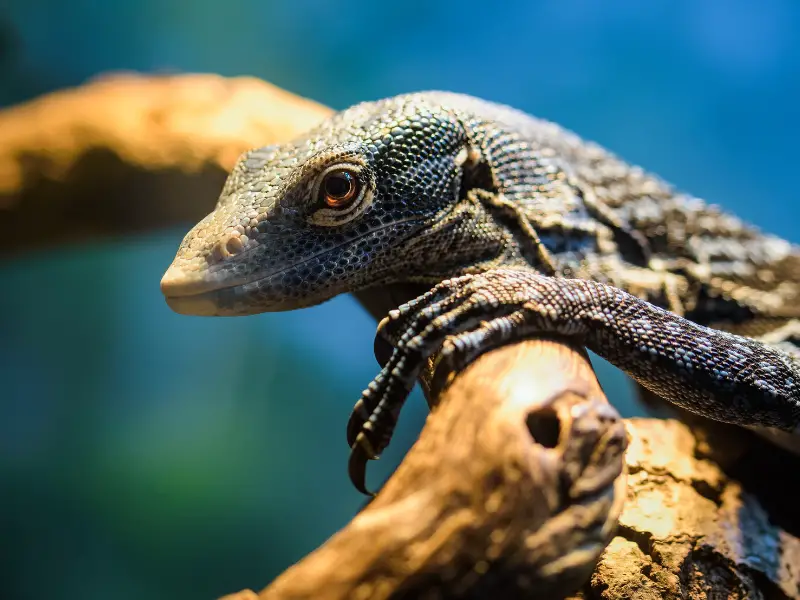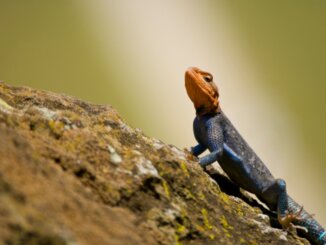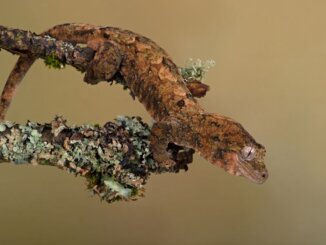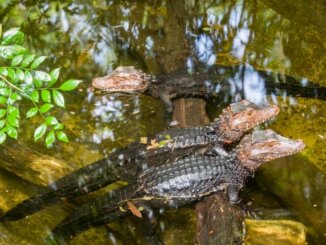
The black tree monitor is an intriguing species of lizard found in the Aru Islands, just off the coast of New Guinea. This monitor is highly intelligent and sensitive, with well-developed problem-solving skills and they can become rather friendly toward their owners over time.
Black tree monitors aren’t a reptile species suitable for beginners, as they can be tricky to keep. However, they’re excellent pets for those with some experience in reptile care. Find everything you need to know about black tree monitor care below.
| Common name | Black Tree Monitor, Beccari's Monitor |
| Scientific name | Varanus beccarii |
| Natural habitat | Moderate to hot arid climates Originates from the Aru Islands. Prefers a dry, warm, humid habitat, and lives mainly in trees |
| Adult size | 3 - 4 ft long (90-120cm) |
| Average lifespan | 10 - 15 years |
| Diet | Invertebrates, insects, small mammals |
| Housing | Large enclosure (minimum 4ft x 4ft x 2ft)Large enclosure (minimum 4ft x 4ft x 2ft)Large enclosure (minimum 4ft x 4ft x 2ft)Large enclosure (minimum 4ft x 4ft x 2ft)Large enclosure (minimum 4ft x 4ft x 2ft)Large enclosure (minimum 4ft x 4ft x 2ft) |
| Experience | Intermediate |
Origin
The Black Tree Monitor (Varanus beccarii) is found in the Aru Islands, part of Indonesia, located just off the coast of New Guinea.
Although rare, you may spot them high up in the trees. They thrive in dry, humid, jungle-style environments.
Appearance And Behavior

Adults are entirely black. However, juveniles are dark gray with neat rows of green and yellow spots that eventually fade away.
Generally speaking, males are slightly bigger than females.
What’s unique about this species of monitor lizard is its long tail. The tail can measure up to two-thirds of its entire body and is prehensile. Monitors can wrap their tails around things like branches and use them to stabilize themselves.
While most monitors use their tails as defense mechanisms, black tree monitors use them as an extra limb. The primary use of its tail is to balance the body.
Because of this weight distribution, the black tree monitors have tremendous balance, allowing them to move quickly. It’s also for this reason that they are agile climbers.
These monitors have long, slender forelimbs with elongated digits. They have long, sharp claws and adhesive soles that help them to hold onto trees and catch prey.
These reptiles also have exceptionally sharp teeth.
They are known to be rather skittish and nervous. Don’t worry if your monitor doesn’t seem to want to play immediately – it’s common and will take some time!
Size And Lifespan
An adult black tree monitor will grow between 3-4 feet in length. They can live for over 10 years, usually up to 15 years.
Temperament
Black tree monitors are happy living in solitude. For this reason, it’s best not to house them together.
Male monitors are known to be territorial. When males are in the same space, they rise on their hindlimbs and attack each other. Any fighting can harm your monitor.
Males will tolerate females being in the area during the breeding season.
After mating, females hide their eggs in a warm place away from males. They defend their offspring for a short while before parting ways.
In the wild, they are surprisingly nervous. And although they can be handled, if they feel threatened, it’s common for them to bite, scratch, or defecate.
Housing Black Tree Monitors

Most people recommend a large terrarium where you can mimic its natural tropical climate. This provides the best environment for your monitor!
Housing them in the right conditions ensures your reptile is robust and healthy.
As arboreal reptiles, they need more space to climb rather than room on the ground.
A glass screen enclosure isn’t recommended because these monitors are unfamiliar with glass and can bump and injure their noses against it.
Enclosure Size
Juvenile monitors can be kept in smaller enclosures (18″ x 18″ x 24″) for around 6 to 8 months.
After this time has passed, you will need to get a larger enclosure for your monitor.
Contrary to popular belief, keeping monitors in a small enclosure cannot stop them from growing. A small enclosure makes your monitor cramped and unhappy.
For an adult monitor, the enclosure must be a minimum of 4ft x 4ft x 2ft. However, a bigger enclosure is always better for your monitor. We recommend an enclosure that is around 6ft x 5ft x 3ft.
Lighting
Your monitor needs a decent UVB lamp to replicate its natural jungle habitat. This light will help it absorb calcium and synthesize vitamin D3.
Place the lights on the warm side of the enclosure and set up a 12-hour day/night cycle.
You will also need a basking lamp to emulate the warmth of their natural environment.
Temperature And Humidity
To mimic their natural environment, you need to establish two separate areas in the enclosure: an area for basking and a space for cooling.
These reptiles are cold-blooded and must move between different environments to regulate their body temperatures.
Here are the recommended temperatures for the enclosure:
- Basking temperature: 95-100℉
- The ambient temperature of the rest of the enclosure: 78-80℉
- Nighttime temperature: 76℉
To achieve these temperatures, you can use a good heat lamp. Make sure you check the temperatures regularly with a thermometer.
Humidity should be kept at around 60 – 80%, depending on where you live. Spray the enclosure with a hand mister or an automatic mister a few times a day to provide enough moisture for your monitor.
You can use a gauge to track the humidity levels.
Maintaining the correct humidity levels can help with skin shedding.
Substrate And Decoration
Black tree monitors are intelligent, curious creatures. As highly skilled climbers, they love to spend time up in the trees, observing their surroundings.
To stimulate your monitor, fill its enclosure with numerous decorations such as branches, logs, foliage, and other climbable surfaces. The decorations allow them to run, jump and exert high energy levels.
For sleeping, provide tubes or vines so that they can sleep inside and feel safe.
They also enjoy swimming, and you may consider adding a large, shallow water box for them to swim in. As these monitors prefer being up rather than down, you can use less substrate.
Use a substrate, such as a mix of forest soil, peat moss, and gravel. This substrate holds moisture well.
Consider investing in some puzzle feeders to stimulate your monitor. In the wild, they have been observed using their forelimbs to catch prey when located in tricky, tight corners.
Cleaning
Because of the large number of trees and branches, cleaning the enclosure can be pretty tricky. You should spot-clean the enclosure regularly and clean its swimming water box daily.
Regularly change the substrate and remove any feces and contaminated substrate. Churn the substrate weekly.
Ensure you replenish their drinking water daily and thoroughly clean the water bowl once a week.
Black Tree Monitor Care

It’s best to have experience with reptiles before jumping in and buying a black tree monitor. That said, once you’ve correctly set up its enclosure, there’s not much else to do.
Let’s look at how to take care of your monitor.
Food And Water
Feed your monitor daily unless they’re overweight. In this case, every other day will suffice.
These monitors eat insects, small lizards, and small mammals such as shrews, scorpions, eggs, and bird nestlings in the wild.
In captivity, they have been known to eat plants, earthworms, mealworms, and wax worms.
Newborns may refuse to eat for up to two weeks after hatching. Sometimes, it’s recommended to force-feed them to avoid starvation. If this happens, you should always seek a professional opinion.
Make sure you give your monitor enough water. A sizable fresh bowl of water should be replenished daily and cleaned well with a reptile-friendly disinfectant once a week.
Handling
Like other reptiles, black tree monitors prefer not to be handled. It’s best to love them from afar.
Despite your excitement when you first bring them home, waiting a while before handling them is recommended. Give your monitor time to get used to you and its new environment.
Let your monitor observe you when you feed it. Talk to it, but wait to pick it up. Let them be curious and slowly get to know you and your voice.
Eventually, it’ll come to you. It may jump up onto your arm when you give it food. Allow it to stay there while you talk, and gently pet it.
However, avoid excessive handling so that you don’t stress out your pet.
Common Health Issues
If your monitor stays still for hours or appears to be hiding, it may be sick. Here are some common health problems and how to treat them:
- Dehydration: To avoid dehydration, provide plenty of fresh water daily and spray the enclosure regularly to give it enough moisture.
- Stress: These monitors are nervous and don’t deal well with stress. To accommodate this, let your monitor slowly acclimate to its new home and wait to attempt to handle it. When handling, be very gentle.
- Dysecdysis: If your monitor hasn’t shed its skin correctly, bathe it in warm water for 10-15 minutes and then gently peel the skin away yourself. If it’s having problems shedding skin around the eyes, apply an artificial tear ointment and gently remove the skin after 10 minutes.
Breeding
Little is known about the black tree monitor’s reproduction in their natural habitat. They’re rarely bred in captivity. However, some breeders have had successful breeding outcomes.
Here’s what to do for successful breeding:
- Carefully arrange the environment for two monitors. Include live plants, a misting system, and trees for climbing. Correct humidity is imperative.
- Introduce the male and female monitors before placing them in the enclosure together.
- Bring the monitors together in the same enclosure. Breeding should occur within a few days.
- When eggs are found around 30 days later, immediately place them in an incubator with a temperature of 86°F. They’ll hatch approximately 164 days after incubation.
Choosing And Buying A Black Tree Monitor

Purchasing one of these unique lizards is quite an investment. Prices start from $600, although they can be in the thousands. It would help if you always bought these from a reputable breeder to make sure it’s legal and worth the price tag.
However, most, if not all, are wild-caught, as captive breeding is very rare. Please talk with a veterinarian and ask them to check the reptile before bringing it home.
Make sure to do your homework to be fully prepared to take care of your monitor. They have been known to struggle in new environments but you can mitigate this by having a perfect home ready for them.
Although they require a higher level of care, black tree monitors are wonderful pets for reptile enthusiasts.




